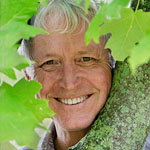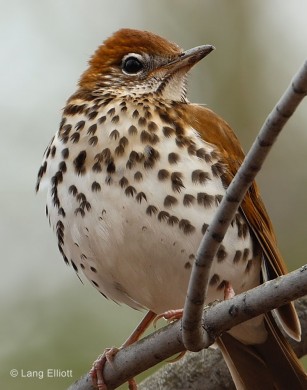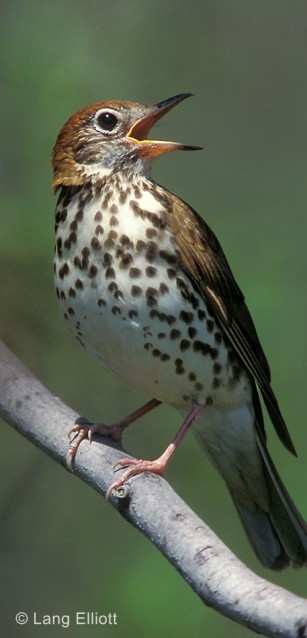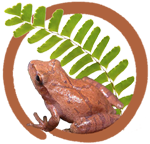Wood Thrush – Forest Flautist
A Nature Vignette by Lang Elliott
Lee-o-lay-o-lee, will you come live with me, away high in a tree? … that’s how I describe the Wood Thrush’s singularly beautiful song. Starting with soft grunts (heard only at close range), the flutey song usually rambles upward and then terminates with a variable trill. Each male has about a dozen different song patterns, some sounding very similar to one another (he actually has many more, if one includes subtle variations in portions of each song).
Inhabiting hardwood forests throughout most of eastern and central North America, the Wood Thrush is a fairly common species, though suffering in recent decades from significant population declines. The song of the Wood Thrush is undeniably one of the most beautiful of all forest melodies … it will surely be a sad day if woodies no longer grace our forests with their uplifting songs!
As with all our native thrushes, the magical quality of the song is best appreciated when heard at a distance, where the song is more reverberant and has merged with the total soundscape and environment. The following ambient recording was made in a deep ravine in the Smoky Mountains in late April. Two distant thrushes can be heard, along with a trickling brook and other bird songs:
Distant thrushes and stream. 5:45 am, 18 May 2000, near Gatlinburg, Tennessee. © Lang Elliott.
??ADD WOOD THRUSH RETURN – Soundscape Recording??
Arthur A. Allen, one of the founders of the Cornell Laboratory of Ornithology, was a master at describing bird songs, and I have always been fascinated by the sensitivity of his prose. Consider, for example, his opening paragraphs in an essay entitled “Wood Thrush,” featured in a Cornell Rural School Leaflet published in 1909. Would that I could capture the essence of the human listening experience so well (note how he brilliantly sets the scene and then gradually wanders toward the full impact of the thrush’s song):
Arthur Allen Quote:
Who has sat on the bank of a shaded glen or at the edge of a cool wood just as the shadows begin to lengthen and the bright light of day begins to take on the mellow tone of a May twilight? The little brook gurgles just out of sight, and water dripping from the rocks strikes the surface of a pool with a music that cannot be described. The silence seems broken only by these sounds and the murmur of the wind among the new born leaves.
Suddenly you become aware that other music is filling the woods. It has come to you so gradually, has been so much a part of the murmuring stream and dripping water that you have not noticed its beginning. All at once it forces itself upon your consciousness and you realize that you have been hearing it all the while. Now that you have noticed it, everything else sinks into insignificance and the top of the tall maple seems to resound with pure, rich, flute-like tones.
“Come—to—me” say the first few notes in the sweetest cadence, so deliberate, so majestic, so fully toned for the music of a bird, that we may truly call the author of it the king of songsters. This song we shall remember though we forget all others. It is that of the Wood Thrush.
From: “Wood Thrush” by Arthur A. Allen. Cornell Rural School Leaflet, May 1909, Vol.2, No.9
Neighboring males often sing back-and-forth, with minimal overlap of their songs. From a distance, this might sound like one male singing rapidly, but careful listening reveals that there are two males involved.
Two Wood Thrushes countersigning. 6:30 am, 16 June 1995, near Ithaca, New York. © Lang Elliott.
Like most of our native thrushes, the Wood Thrush often sings at dusk. At that time, one may sense a profound spiritual quality in the songs, as if they were solemn yet beautiful offerings, portals into the magic of the night.
1. “Typical Song” begins with soft grunting notes, followed by an upward ramble of flutelike notes that terminate with a trill. Each male has around 8-10 clearly-different songs in his repertoire, plus ten or more subtle variants:
2. Calls include outbursts of variable bup and pit notes given in brief volleys. These calls sometimes intergrade with one another and may vary considerably in loudness and pace of delivery (loud and fast volleys probably indicate the bird is upset about something):
3. Here is another example of pit volleys:
4. Buzzy eek! calls are often given during migration and when taking flight. Eeks can be heard in this recording along with bup volleys:
Note: Sound recordings © Lang Elliott – All Rights Reserved.
- Scientific name is Hylocichla mustelina. Recognized by reddish-brown upper-parts set against white under-parts speckled with numerous large, dark spots (our other native thrushes have more subtle spotting).
- Member of the thrush family, Turdidae, which, along with our other thrushes, includes the American Robin, our various bluebirds, and Townsend’s Solitaire.
- Breeds in mixed and deciduous forest habitats throughout most of eastern North America (see range map).
- Nests in the lower branches of understory shrubs or saplings. Lays 3-4 blue eggs. Young hatch in about 14 days.
- Neotropical migrant. Populations have been declining since the 1970s, due to forest fragmentation both on the summer breeding grounds and on wintering areas (from southern Mexico to Panama; see map).
- During spring migration, arrives along the gulf coast in mid-April and appears in northernmost areas by mid-May.
- Feeds mostly on soil invertebrates, but may eat fruit, especially in late summer and during migration.
What You Can Do:
If you live within the Wood Thrush’s breeding range, find a male (or preferably two or more neighboring males) on territory in hardwood or mixed forest. If you don’t know where to look, consult a birder who might very well know right where you should go. To help get in the proper frame of mind, read Arthur Allen’s quote above, and contemplate how nice it would be to experience what he experienced.
Rise before dawn and travel to Wood Thrush’s home, arriving just before first light. Quietly enter the forest and find a place to sit … on a log, a rock, or mound of earth (bring a pillow or pad so that you can remain comfortable). Relax into the landscape and listen for the first song of the thrush. As his singing bout unfolds, remain aware of other sounds in his surroundings, and of the thrush himself, his varying repertoire of songs, and how he moves periodically from perch to perch in the semi-darkness. If there is a neighboring male nearby, listen for counter-singing, as the two males sing back-and-forth near their territory boundary.
Sink into the essence of the experience, into the pure delight of listening to the thrush’s music, interwoven with all the other sounds of nature … other singing birds, leaves moving in the light breeze, the trickle of a nearby brook. Experience the pure joy of being in the wild, of witnessing such an extraordinary natural event.
And where the shadows deepest fell, the wood thrush rang his silver bell.
— Henry Wadsworth Longfellow
This bird never fails to speak to me out of an ether purer than what I breathe, of immortal beauty and vigor. He deepens the significance of all things seen in the light of his strain. He sings to make men take higher and truer views of things.
— Henry David Thoreau (July 5, 1852)
As I come over the hill, I hear the wood thrush singing his evening lay. This is the only bird whose note affects me like music, affects the flow and tenor of my thought, my fancy and imagination. It lifts and exhilarates me. It is inspiring. It is a medicative draught to my soul. It is an elixir to my eyes and a fountain of youth to all my senses.
— Henry David Thoreau (June 22, 1853)
Like liquid pearls fresh showered from heaven,
The high notes of the lone wood-thrush
Fall on the forest’s holy hush.
— John Townsend Trowbridge (1903)
Notes from the Author (Lang Elliott):
 For a number of years, I had trouble getting good video footage of a singing Wood Thrush. The usual problem is that singing males are timid and almost always are perched behind leaves, high in the canopy. In the spring of 2014, however, I got lucky and discovered a newly-arrived male who didn’t seem to mind me standing around in his woodland territory, sometimes only thirty feet away. On one day in particular, he put on quite a show and that’s when I got all the footage featured in the video portrait at the top. At long last … Wood Thrush success!
For a number of years, I had trouble getting good video footage of a singing Wood Thrush. The usual problem is that singing males are timid and almost always are perched behind leaves, high in the canopy. In the spring of 2014, however, I got lucky and discovered a newly-arrived male who didn’t seem to mind me standing around in his woodland territory, sometimes only thirty feet away. On one day in particular, he put on quite a show and that’s when I got all the footage featured in the video portrait at the top. At long last … Wood Thrush success!
Learn more about Lang Elliott at musicofnature.com
Did you enjoy this Nature Vignette?








Absolutely beautiful. My favorite woodland songster and you captured it so wonderfully, in both visuals and the quotes. I hope your new web site reaches countless viewers.
What a pure delight. I just love all of these.
why thank you!